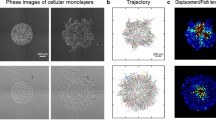Abstract
TRANSFORMED CELLS are frequently less adhesive than normal cells. This decrease in adhesion has been associated with the loss of specific cell surface proteins, changes in morphology, alterations in the underlying cytoskeleton and the increased activity of the serine protease, plasminogen activator1–3. Hepatoma tissue culture (HTC) cells exhibit increased levels of adhesion to glass4,5 and decreased plasminogen activator activity6,7 when incubated in the presence of the synthetic glucocorticoid, dexamethasone. Plasminogen activator converts plasminogen in serum to plasmin. It has been shown that plasmin causes the reversible dissociation of intracellular actin-containing cables in anchorage-dependent rat embryo cells8 and may also be partially responsible for decreased adhesion of Rous sarcoma virus-transformed chicken embryo fibroblasts3. Cell–substrate adhesion presumably requires specific cell surface glycoproteins and intact cytoskeletal elements9,10. It is possible that plasmin acts either to modify ‘adhesive’ proteins on the cell surface or to disrupt linkages between these surface components and the underlying cytoskeleton. We have used variant HTC cells selectively resistant to the dexamethasone inhibition of plasminogen activator6 to test the hypothesis that hormonal induction of cell adhesion is secondary to the inhibition of plasminogen activator which in turn allows the accumulation of the glycoproteins necessary for adhesion. We have modified cell adhesion assay techniques5,11 to provide a sensitive measure of cell–substrate adhesion for both wild-type and variant HTC cells in the presence and absence of serum and plasminogen. We report here that plasminogen activator does not have an important role in the hormonal regulation of HTC cell adhesiveness.
Similar content being viewed by others
References
Shields, R. & Pollock, K. Cell 3, 31–38 (1974).
Unkeless, J. C. et al. J. exp. Med. 137, 85–111 (1973).
Weber, M. J. Cell 5, 253–261 (1975).
Ballard, P. L. & Tomkins, G. M. Nature 224, 344–345 (1969).
Ballard, P. L. & Tomkins, G. M. J. Cell Biol. 47, 222–234 (1970).
Carlson, S. A. & Gelehrter, T. D. J. supramolec. Struct. 6, 325–331 (1977).
Wigler, M., Ford, J. P. & Weinstein, I. B. in Proteases and Biological Control, 849–856 (Reich, E, Rifkin, D. B. & Shaw, E. eds) (Cold Spring Harbor Press, New York, 1975).
Pollack, R. & Rifkin, D. Cell 6, 495–506 (1975).
Rees, D. A., Lloyd, C. W. & Thom, D. Nature 267, 124–128 (1977).
Willingham, M. C., Yamada, K. M., Poussegur, J. & Pastan, I. Cell 10, 375–380 (1977).
Walther, B. T., Ohman, P. & Roseman, S. Proc. Natn. Acad. Sci. U.S.A. 70, 1569–1573 (1973).
Spencer, C. J. & Gelehrter, T. D. J. biol. Chem. 249, 577–583 (1974).
Culp. L. A. & Buniel, J. F. J. cell. Physiol. 88, 89–106 (1976).
Grinnell, F. Archs Biochem. Biophys. 169, 474–482 (1975).
Ivarie, R. D. & O'Farrell, P. H. Cell 13, 41–55 (1978).
Deutsch, D. G. & Mertz, E. T. Science 170, 1095–1096 (1970).
Strickland, S. & Beers, W. H. J. biol. Chem. 251, 5694–5702 (1976).
Author information
Authors and Affiliations
Rights and permissions
About this article
Cite this article
FREDIN, B., SEIFERT, S. & GELEHRTER, T. Dexamethasone-induced adhesion in hepatoma cells: the role of plasminogen activator. Nature 277, 312–313 (1979). https://doi.org/10.1038/277312a0
Received:
Accepted:
Issue Date:
DOI: https://doi.org/10.1038/277312a0
- Springer Nature Limited
This article is cited by
-
Establishment of a xeno-free culture system that preserves the characteristics of placenta mesenchymal stem cells
Cytotechnology (2015)
-
Hydrocortisone-induced accumulation of fibronectin mRNA and cell surface-associated fibronectin
Journal of Cancer Research and Clinical Oncology (1988)
-
Mouse hepatocyte synthesis and induction of the acute phase reactant: Serum amyloid P-component
In Vitro (1984)





